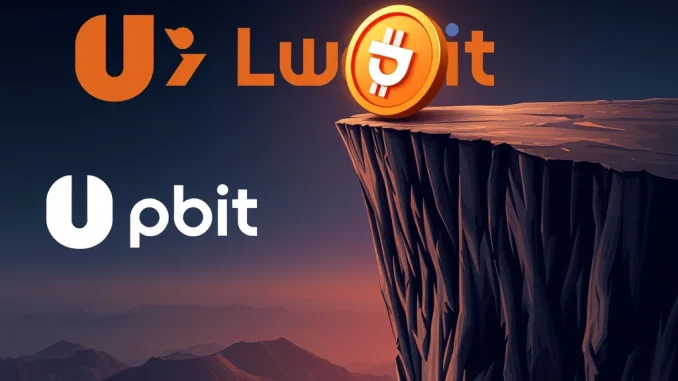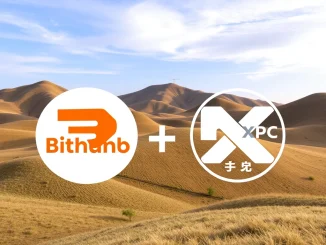
Breaking News for LOOM Holders! If you’re holding Loom Network (LOOM) tokens, you need to pay close attention. South Korean crypto giants Upbit and Bithumb have just dropped a bombshell announcement: they are delisting LOOM from their platforms. This sudden news has sent ripples through the crypto community, leaving LOOM holders scrambling to understand what’s next. Let’s dive into the details of this critical development and what it means for you.
Why are Upbit and Bithumb Delisting LOOM?
Both Upbit and Bithumb, leading cryptocurrency exchanges in South Korea, made separate announcements on their respective websites, stating that Loom Network (LOOM) will be officially delisted on May 7th at 06:00 UTC. This synchronized decision by two major exchanges raises eyebrows and prompts questions about the reasons behind this move. While the exchanges haven’t explicitly detailed the exact reasons, delistings typically occur due to a variety of factors. These can include:
- Low Trading Volume and Liquidity: Exchanges want to host actively traded cryptocurrencies. If LOOM’s trading volume has decreased significantly on these platforms, maintaining its listing might become less profitable for Upbit and Bithumb.
- Regulatory Concerns: Cryptocurrency regulations are constantly evolving, especially in South Korea. There might be regulatory pressures or compliance issues that have led to the decision to delist LOOM.
- Project Developments and Team Activity: Exchanges monitor the projects they list. A lack of ongoing development, decreased team activity, or concerns about the project’s future roadmap can influence delisting decisions.
- Security or Technical Issues: If any security vulnerabilities or technical problems have emerged with the LOOM network, exchanges might delist it to protect their users.
- Failure to Meet Listing Standards: Exchanges have listing criteria that projects must continuously meet. LOOM might have fallen short of these standards in some aspect, triggering the delisting process.
It’s important to note that without official statements detailing the specific reasons, these are potential factors based on common delisting scenarios. For LOOM holders, understanding the ‘why’ is crucial to assess the long-term implications.
Upbit Delist and Bithumb Delist: What’s the Timeline?
Both exchanges have provided a clear timeline for the LOOM delisting process. Here’s a breakdown of the key dates and times:
| Exchange | Delisting Date & Time (UTC) | Key Action |
|---|---|---|
| Upbit | May 7, 06:00 UTC | LOOM delisting from Upbit KRW, BTC, and USDT markets. Trading support ends. |
| Bithumb | May 7, 06:00 UTC | LOOM delisting from Bithumb KRW market. Trading support ends. |
After May 7th, trading of LOOM will cease on these exchanges. However, it’s crucial to understand the withdrawal support timeline. While trading stops on May 7th, users will typically have a period to withdraw their LOOM tokens from the exchanges. It’s imperative for LOOM holders on Upbit and Bithumb to check the official announcements on each exchange’s website for the specific withdrawal deadline. Missing this deadline could lead to complications in accessing your tokens.
Impact of Crypto Delisting on LOOM Holders
A crypto delisting from major exchanges like Upbit and Bithumb can have significant consequences for holders of the affected token. Let’s explore the potential impacts:
- Price Drop: Delisting announcements often trigger a sharp decline in the token’s price. As traders rush to sell their holdings before trading ceases, selling pressure increases dramatically. This is a common immediate reaction to delisting news.
- Reduced Liquidity: Once delisted, LOOM will no longer be tradable on Upbit and Bithumb. This significantly reduces the liquidity of the token, making it harder to buy or sell. Holders will need to find alternative exchanges that still support LOOM, which might have lower trading volumes.
- Limited Trading Options: With fewer exchanges supporting LOOM, trading options become restricted. This can impact the ability to trade LOOM against various trading pairs and potentially increase trading costs due to lower liquidity and wider bid-ask spreads on remaining exchanges.
- Negative Sentiment: Delistings can create negative sentiment around a cryptocurrency project. It can be perceived as a lack of confidence from exchanges and the broader market, potentially affecting the project’s reputation and future prospects.
- Withdrawal Deadlines: Holders must adhere to the withdrawal deadlines set by Upbit and Bithumb. Failure to withdraw LOOM tokens before the deadline could result in complications or even loss of access to the tokens held on these exchanges.
South Korea Crypto Exchange Landscape and Delistings
The South Korea crypto exchange market is known to be highly regulated and competitive. Korean exchanges often have stringent listing and delisting policies. Delistings, while impactful, are not uncommon in this environment as exchanges strive to maintain high standards and comply with evolving regulations. The synchronized delisting of LOOM by Upbit and Bithumb, two of the largest exchanges in the country, highlights the seriousness of this situation.
For projects operating in or targeting the South Korean market, maintaining good standing with local exchanges is crucial. This includes transparent communication, consistent project development, and adherence to regulatory guidelines. Delistings serve as a reminder of the dynamic nature of the crypto market and the importance of continuous project maintenance and community engagement.
Actionable Insights for LOOM Holders
If you are currently holding LOOM tokens on Upbit or Bithumb, here are crucial steps you need to take immediately:
- Withdraw Your LOOM: Your top priority is to withdraw your LOOM tokens from Upbit and Bithumb before the withdrawal deadline. Check the official announcements on each exchange for the specific deadline.
- Explore Alternative Exchanges: Identify other cryptocurrency exchanges that still support LOOM trading. You can use platforms like CoinGecko or CoinMarketCap to find exchanges listing LOOM and assess their trading volume and liquidity.
- Consider Cold Storage: If you plan to hold LOOM for the long term, consider transferring your tokens to a personal crypto wallet (cold storage). This gives you full control over your tokens and reduces reliance on centralized exchanges.
- Stay Informed: Keep a close watch on official announcements from Loom Network and any updates regarding the delisting situation. Follow reputable crypto news sources for further developments.
- Assess Your Strategy: Evaluate your investment strategy for LOOM. Consider the impact of the delisting on the token’s future prospects and decide whether to hold, sell on other exchanges, or adjust your portfolio accordingly.
Conclusion: Navigating the LOOM Delisting Shockwave
The news of Upbit and Bithumb delisting Loom Network (LOOM) is undoubtedly a significant event for LOOM holders. It serves as a stark reminder of the volatile and ever-changing nature of the cryptocurrency market. While delistings can be unsettling, proactive steps and informed decision-making are key to navigating such situations. For LOOM holders, immediate action regarding token withdrawal and strategic portfolio adjustments are crucial in the wake of this shocking announcement. Stay vigilant, stay informed, and always prioritize the security of your crypto assets.



